Clownfish were beloved saltwater aquarium fish even before Pixar immortalized Nemo on screen and have inspired many of us to create a tiny slice of the reef in our own fish tanks. This article is a guide to the different clownfish types to help you select there right one for your tank.
There are several different scientific classifications of clownfish types called complexes (Ocellaris, Percula, Maroon, Tomato, Skunk, etc. are considered complexes). Within each of the complexes are varieties, strains or types that have been created as a result of multiple generations of selective breeding by aquaculture organizations.
List of 19 Best clownfish types
Here is a list of the most popular clownfish types:
- Ocellaris
- DaVinci
- Black (aka. Darwin)
- Wyoming White
- Snowflake
- Black Ice
- Percula
- Picasso
- Maroon
- Lightning Maroon
- Gold striped Maroon
- Tomato
- Cinnamon
- Red Saddleback Tomato
- Skunk
- Pink Skunk
- Orange Skunk
- Clarkii
- Saddleback
| Common name | Genus and Species | Aggression level | Adult Size | Minimum Tank Size | Reef safe |
|---|---|---|---|---|---|
| Ocellaris Clownfish | Amphiprion ocellaris | Low | 3 in. | 10-gallon | Yes |
| Percula Clownfish | Amphiprion percula | Low | 3 in. | 10-gallon | Yes |
| Maroon Clownfish | Amphiprion biaculeatus | High | 6 in. | 30-gallon | Yes |
| Tomato Clownfish | Amphiprion frenatus | Moderate | 5 in. | 30-gallon | Yes |
| Cinnamon Clownfish | Amphiprion melanopus | Moderate | 5 in. | 30-gallon | Yes |
| Pink Skunk Clownfish | Amphiprion perideraion | Low | 4 in. | 10-gallon | Yes |
| Orange Skunk | Amphiprion akallopisos | Low | 4 in. | 10-gallon | Yes |
| Clarkii Clownfish | Amphiprion clarkii | Moderate | 6 in. | 30-gallon | Yes |
| Saddleback Clownfish | Amphiprion polymnus | Moderate | 4 in. | 30-gallon | Yes |
Ocellaris Clownfish (Amphiprion ocellaris)
The clownfish species that started it all, Nemo is one of the most popular clownfish species and is a staple among local fish stores. Within this Ocellaris Clownfish complex, there are several very popular clownfish types. Taxonomically, these clownfish types are all the same species, Amphiprion ocellaris, but they have different coloration and striping patterns.
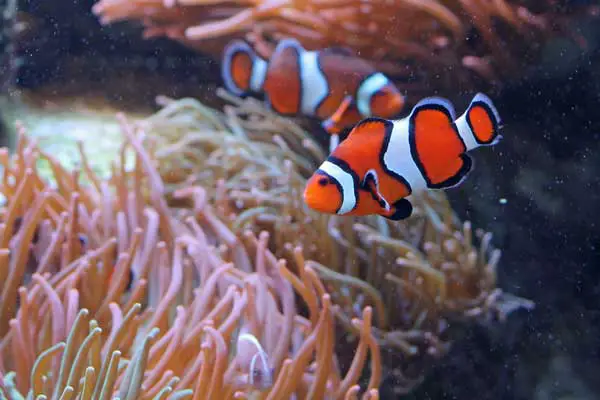
The main Ocellaris clownfish types are:
- DaVinci
- Darwin (Black clownfish)
- Wyoming White
- Snowflake
- Black Ice
DaVinci
The popular DaVinci clownfish has the classic orange, white and black coloration, but where they differ is in the design of the stripes, as you can see below.

Black clownfish aka. Darwin (Ocellaris variant)
The black clownfish, also known as the Darwin Ocellaris retains the classic 3-ring striping pattern but the entire rest of the body is black. These fish are born orange and turn darker over time.

Wyoming white ocellaris
Covered nearly from nose to tail with one big giant white ‘stripe’ the Wyoming white clownfish type is popular because of this unusual striping pattern.
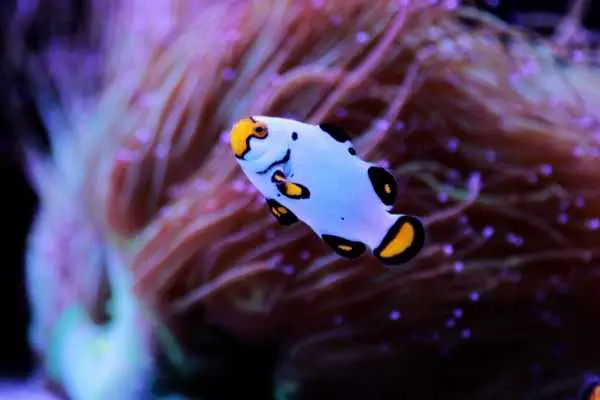
Snowflake Ocellaris
The Snowflake clownfish type is also an Amphiprion ocellaris species that appears to be somewhat of a mashup, or in-between version of the common clown and the Wyoming White. They get their name from the irregular patterns (like a snowflake) on both sides of the border of their middle stripe.
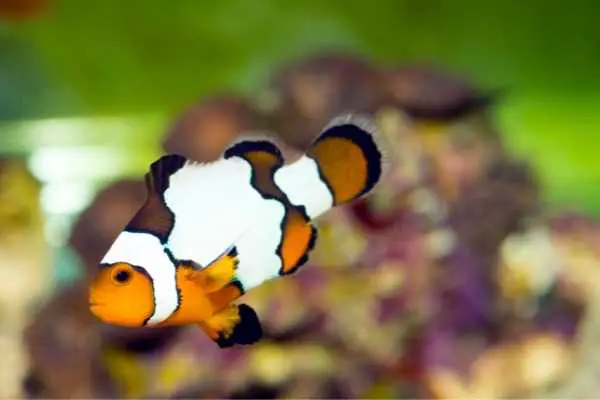
Black ice Ocellaris
The black ice clownfish type (image shown below) has more black pigment than most of the other orange varieties, as well as a ‘snowflake’-like middle section.

Percula
The Percula, or True Percs, as they are sometimes called, are another popular group of orange and black clownfish. Two color morphs are shown below, hosting on these mushroom corals.
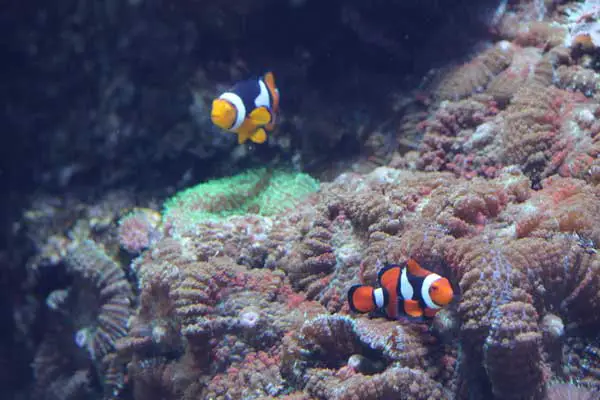
Picasso clownfish
The Picasso clownfish type is a True Percula species (Amphiprion percula). As you can see in the image below, this variation is characterized by a Picasso-inspired abstract arrangement o the stripes.

Maroon
The Maroon clownfish complex has some of the largest and most aggressive clownfish types. The traditional maroon clownfish has white stripes on a dark maroon body.
Maroon clowns also have a distinctly different shape than their Ocellaris and Percula counterparts, and they also have a cheeks-spine on the outside of their gill cover.
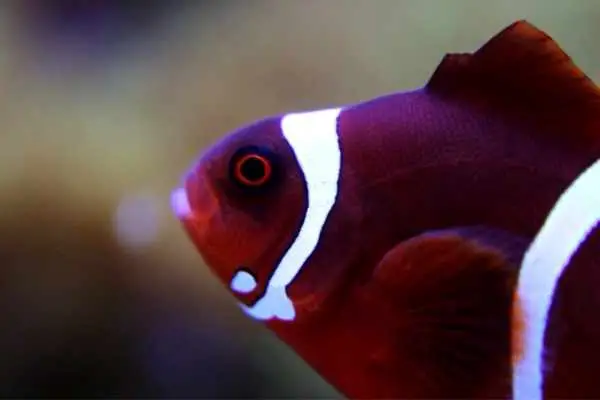
Lighting Maroon
The lightning maroon has a less traditional striping pattern that involves little bubbles of red as well as stripes/markings that expand beyond the traditional clownfish rings.
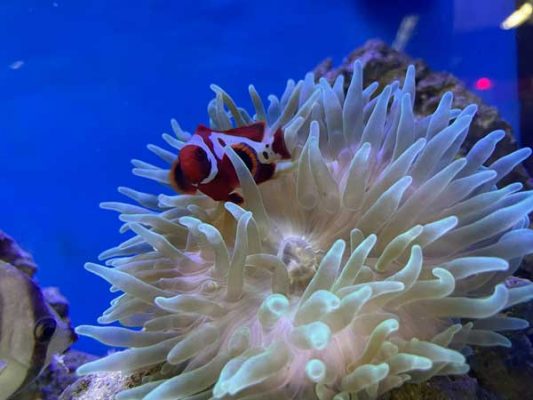
Gold striped maroon
The gold-striped maroon clownfish starts out looking like any other juvenile maroon, but over time, the stripes change color and become golden/yellow.
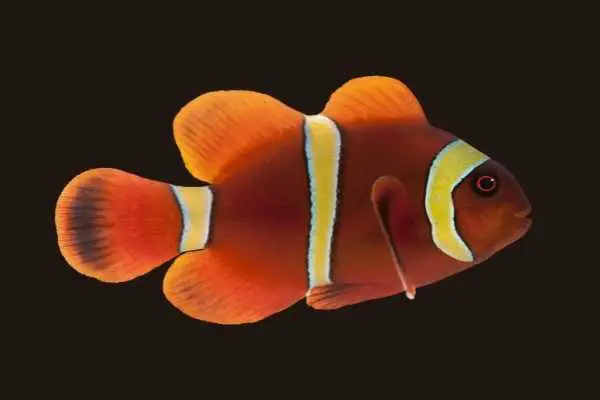
Tomato
The Tomato clownfish complex boasts a large, rounder body with a single white stripe (for many varieties) on the head that goes most of the way around.
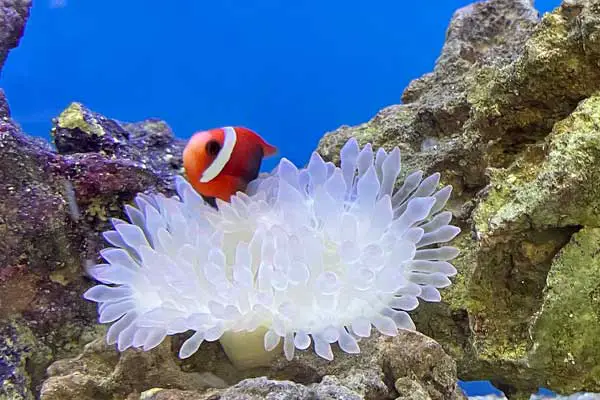
Cinnamon
The Cinnamon clownfish, as you can see below, retains the classic Tomato shape and striping pattern, but the body is naturally much darker.
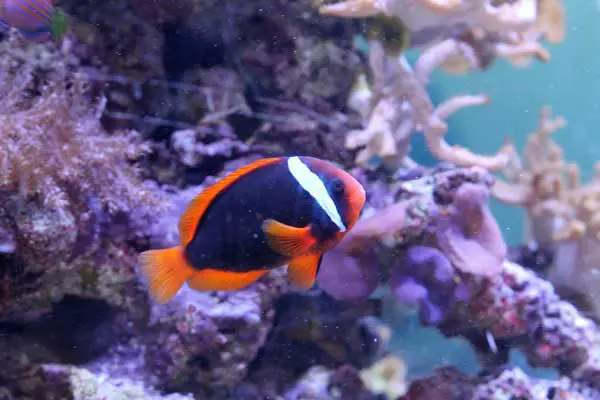
Red Saddleback tomato clownfish
If the Red Saddleback tomato clownfish below weren’t swimming in a bubble tip anemone, you might do a double-take to even decide whether or not they are a proper clownfish.

Skunk clownfish complex
The Skunk clowns are generally mild-mannered, even for a clownfish type. These adorable fish take their stripes in a new direction and have a skunk-like markings that run from their noses to their tails along their dorsal fin.
Pink skunk
The Pink Skunk clownfish boasts a pink coloration (my wife says it looks like raw chicken…), a thin white skunk stripe and white stripes along the gill plates that don’t go all the way around the head.
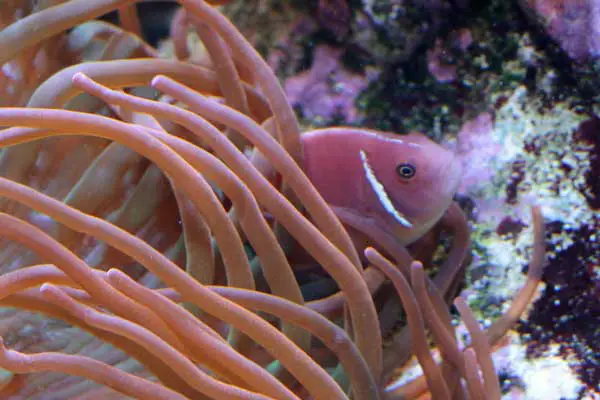
Orange Skunk
The Orange Skunk clownfish is not quite as orange in color as Ocellaris or Percula clownfish, but boasts a much thicker skunk-stripe than the Pink Skunk that extends from lips to tail

Clarkii
The Clarkii clownfish complex is a relatively large clownfish type. Their markings combine bumblebee like yellow, black and white.
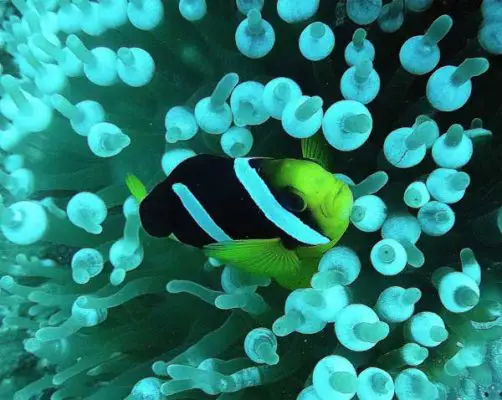
Saddleback
The Saddleback clownfish are probably the least well known of any of the clownfish types in this article. They have a prominent stripe around their heads that is quite thick, and the second and third stripes seem to have migrated away from their abdomen and create a saddle-like structure right where a tiny underwater cowboy would place a saddle, I suppose.

Lifespan of a Clownfish
The longest recorded lifespan of a clownfish was between 9 and 22 years, depending on the individual species, with the oldest known Clarkii clownfish at 9 years (and still alive at the time of the survey) and an Ocellaris clownfish at 22 years (and still alive at the time of the survey).
My personal experience is that some individuals you get from the store will be extremely short-lived, while others will stay with you for years, if not a decade or more.
Source: Sahm, A., Almaida-Pagán, P., Bens, M. et al. Analysis of the coding sequences of clownfish reveals molecular convergence in the evolution of lifespan. BMC Evol Biol 19, 89 (2019). https://doi.org/10.1186/s12862-019-1409-0
Clownfish price
The price of a clownfish will vary significantly based on the perceived availability or rarity, particularly among the designer clownfish types. I was in a local fish store the other day and saw gorgeous and large red sea clownfish for $9.99 and designer fish for hundreds of dollars.
The price of the more rare designer types does tend to trend lower over time as hobby breeders enter the market with the next generation.
Clownfish tank mates
Clownfish are great community saltwater fish and will generally get along with any saltwater aquarium fish that will get along with them. It is generally best to only keep one clownfish type per tank, but they can be kept in a tank with different types of tangs, dwarf angelfish, cardinalfish, goby fish, reef safe wrasses, blennies and other popular saltwater fish.
A great place to start is with this list of the 26 best beginner saltwater fish
How many clownfish in a tank
You should only keep one species of clownfish in your tank. Within that species, you can mix Clownfish types and keep at least two individuals, which should pair up, as long as you meet the minimum tank size requirements.
References
Michael, Scott W. Marine Fishes: 500+ Essential-to-Know Aquarium Species. TFH Publications. Neptune City, NJ: 2001.
Sahm, A., Almaida-Pagán, P., Bens, M. et al. Analysis of the coding sequences of clownfish reveals molecular convergence in the evolution of lifespan. BMC Evol Biol 19, 89 (2019). https://doi.org/10.1186/s12862-019-1409-0
Wilkerson, Joyce D. Clownfishes: A Guide to Their Captive Care, Breeding & Natural History. T.F.H Publications. 2001. Neptune City, NJ


Leave a Reply